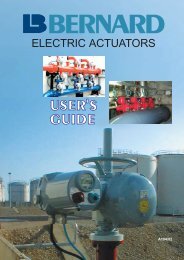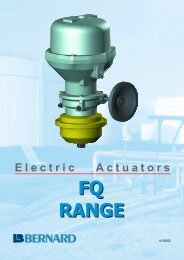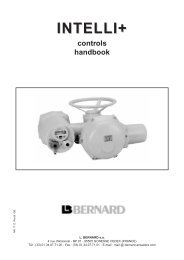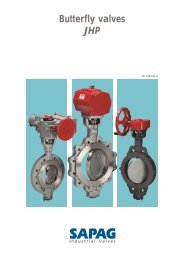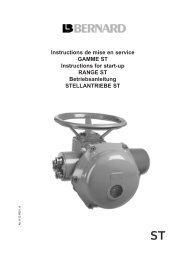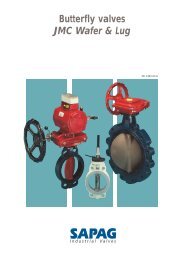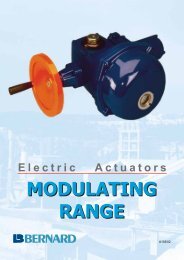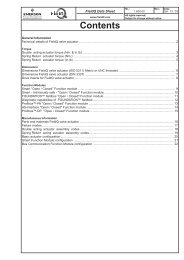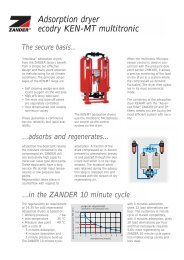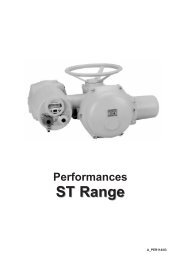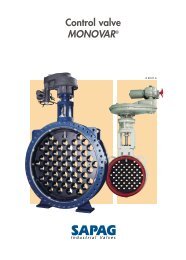Fieldbus command
Fieldbus command
Fieldbus command
You also want an ePaper? Increase the reach of your titles
YUMPU automatically turns print PDFs into web optimized ePapers that Google loves.
<strong>Fieldbus</strong> <strong>command</strong><br />
The field bus is a means for exchanging information and <strong>command</strong>s<br />
with several actuators or sensors over a single electrical line.<br />
Each actuator requires an individual power supply and a communication<br />
line which, in the case of the field bus is common to a set of actuators.<br />
The signal is encoded and an address is assigned to each actuator.<br />
Therefore, each actuator can identify those <strong>command</strong>s which are<br />
intended for it, and the data transmitted by the actuator can be identified.<br />
The advantage of field bus connection is, on the one hand, that several actuators can be connected<br />
over the same line and, on the other, that the amount of data transmitted by each actuator can<br />
be augmented without increasing wiring costs.<br />
A field bus which establishes connection for several actuators over a single line is distinct from an<br />
encoded 4 - 20 mA system (such as the "Hart" system) which is capable of carrying data superimposed<br />
over a 4 - 20 mA signal for a single actuator or sensor.<br />
■ A WIDE RANGE OF FIELD BUS SYSTEMS<br />
As a wide range of field bus systems exist, an actuator can only connect to a bus line if it is equipped<br />
with the field bus specific interface. There are "proprietary" systems, where a single manufacturer<br />
supplies the necessary interfaces, and "open" systems where various manufacturers can supply<br />
interfaces.<br />
With regard to "proprietary" systems, L. Bernard offers the DUPLINE system, branded DS200.<br />
Although proprietary, this system is not L. BERNARD-specific, as the manufacturer is Carlo Gavazzi.<br />
The user can therefore procure additional interfaces directly from Carlo Gavazzi, and is therefore<br />
not dependent on the actuator supplier.<br />
A "proprietary" system always includes the actuators and their bus interface, as well as the bus controller<br />
located at the line head-end, used for the dialog with the PLC which controls the process.<br />
Communication with the PLC also uses a bus system. In general MODBUS is used.<br />
In the electric actuator area, "open" systems are essentially:<br />
● PROFIBUS<br />
● MODBUS<br />
● FIELDBUS FOUNDATION<br />
With an "open" system, the actuator or sensor supplier usually limits its offer to the equipment<br />
equipped with the bus interface. The bus controller is generally incorporated to an extension of the<br />
PLC.<br />
■ DUPLINE FIELD BUS<br />
The complete range of L. BERNARD actuators can be equipped with the DUPLINE field bus interface.<br />
Each actuator is offered as an integral version, meaning it comes complete with contactors and is<br />
handled by an electronic board. This part may come as a separate unit.<br />
Both integral versions of the L. BERNARD range can be used: INTEGRAL+ or INTELLI+, with the<br />
addition of the DS200 interface for the DUPLINE system.<br />
A bus controller, installed at the line head-end, is supplied to control the assembly. Communication<br />
with the PLC is via MODBUS.<br />
2 systems are available. A single version is used to control a line of 31 actuators from the DUPLINE
Up to 20 actuators<br />
per line<br />
Up to 16 lines<br />
starts<br />
Up to 10 km length without<br />
loss of performance<br />
MASTER MODULE, or a redundant version from the DS200 CONTROLLER, used to control up to 320<br />
actuators, i.e. 20 actuators per line. The maximum line distance is 10 km.<br />
■ PROFIBUS DP FIELD BUS<br />
The complete range of L. BERNARD actuators can be equipped with the PROFIBUS DP field bus interface.<br />
(Caution: the PROFIBUS DP system cannot be connected to the same circuit as the PROFIBUS<br />
FMS or PROFIBUS PA system). Each actuator is offered as an integral version, meaning it comes complete<br />
with contactors and is handled by an electronic board. This part may come as a separate unit.<br />
Both integral versions of the L. BERNARD range can be used: INTEGRAL+ or INTELLI+, with the addition<br />
of the "PROFIBUS DP 32 I/O" interface for the INTEGRAL+ or the "PROFIBUS DP data transfer"<br />
interface for the INTELLI+.<br />
A PROFIBUS DP line can control up to 30 actuators. Extra line repeaters are required to increase the<br />
number of actuators connected to a given line.<br />
The maximum line distance is 1.2 km, and more with repeaters.<br />
Only the actuator is supplied with its PROFIBUS DP interface. This actuator can connect to any<br />
PROFIBUS DP field bus even if other units are connected. The only requirement is not to exceed the<br />
number of connection points which is 30 max. Each actuator or sensor counts as a connection point,<br />
regardless of the amount of data transmitted.<br />
■ MODBUS RTU FIELD BUS<br />
Actuators of the L. BERNARD range equipped with the INTELLI+ <strong>command</strong> can accommodate the<br />
MODBUS interface. A MODBUS line can control up to 30 actuators. Extra line repeaters are required<br />
to increase the number of actuators connected to a given line.<br />
Only the actuator is supplied with its MODBUS interface. This actuator can connect to any MODBUS<br />
RTU field bus even if other units are connected. The only requirement is not to exceed the number of<br />
connection points which is 30 max. Each actuator or sensor counts as a connection point, regardless<br />
of the amount of data transmitted.<br />
PC<br />
Pressostat<br />
Local control box<br />
PLC<br />
Pump<br />
Electro-valve



